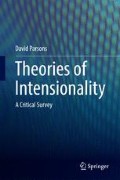Abstract
In the introductory chapter it was suggested that the intension/extension distinction (or some comparable distinction) is fundamental to an intensional logic.
Access this chapter
Tax calculation will be finalised at checkout
Purchases are for personal use only
Notes
- 1.
In fact, Frege’s symbol for identity of content was intended to show how the same content might be determined in different ways: a view that, as will be seen, already mirrored his mature understanding of identity.
- 2.
The compositionality thesis appears to commit Frege to a claim about Sinne which is stronger than the comparable claim about Bedeutungen. Specifically, attempting to exchange component expressions that have different Sinne will apparently always change the Sinn of the whole sentence. But this is not always true in the case of Bedeutungen. For instance, in the sentence ‘Smith is tall’, ‘Smith’ might be exchanged for ‘Jones’, provided that Jones is tall, without altering the Bedeutung of the whole sentence. Yet ‘Smith’ and ‘Jones’ may each have a distinct Bedeutung.
- 3.
This principle could be extended to allow for existential generalisations on the indirect bedeutungen of predicates and sentences. Typically, this would be achieved by means of a second-order logic.
- 4.
In fact, the criterion as it stands will conflict with what Frege has to say elsewhere with regard to the Sinne of sentences such as ‘2 + 2 = 4’ and ‘22 = 4’. For instance, in Grundgesetze der Arithmetik (The Basic Laws of Arithmetic) (1964), where Frege gave his mature exposition of his logic proper, he gives ‘2 + 2 = 4’ and ‘22 = 4’ as examples of two expressions having the same Bedeutung, but differing with regard to the Gedanke that each expresses (Frege 1964, p. 35).
References
Beaney, M. (1996). Frege: Making sense. London: Duckworth.
Frege, G. (1964). In M. Furth (Ed.) Basic laws of arithmetic (M. Furth, Trans.). Los Angeles: University of California Press.
Frege, G. (1972). In T. W. Bynum (Ed.) Conceptual notation and related articles. Oxford: Clarendon Press.
Frege, G. (1980). Philosophical and mathematical correspondence. Chicago: University Press.
Frege, G. (1984). Function and concept. In B. McGuinness (Ed.), Collected papers on mathematics, logic and philosophy (pp. 137–156). Oxford: Blackwell.
Frege, G. (1997a). Comments on Sinn and Bedeutung. In M. Beaney (Ed.), The Frege reader (pp. 172–180). Oxford: Blackwell.
Frege, G. (1997b). A brief survey of my logical doctrines. In M. Beaney (Ed.), The Frege reader (pp. 299–300). Oxford: Blackwell.
Frege, G. (2001). On sense and reference. In A. P. Martinich & D. Sosa (Eds.), Analytic philosophy: An anthology (pp. 7–18). Oxford: Blackwell.
Dummett, M. (1973). Frege: Philosophy of language. London: Duckworth.
Dummett, M. (1981). The interpretation of Frege’s philosophy. London: Duckworth.
Evans, G. (1982). The varieties of reference. Oxford: Clarendon Press.
Kaplan, D. (1971). Quantifying in. In L. Linsky (Ed.), Reference and modality (pp. 112–144). London: Oxford University Press.
Kenny, A. (2000). Frege. London: Blackwell.
Klement, K. C. (2002). Frege and the logic of sense and reference. New York: Routledge.
Kripke, S. (1980). Naming and necessity. Cambridge, MA: Harvard University Press.
Linsky, L. (1983). Oblique contexts. Chicago: The University of Chicago Press.
McCulloch, G. (1989). The game of the name: Introducing logic, language and mind. Oxford: Clarendon Press.
Quine, W. V. O. (1969). Ontological relativity and other essays. New York: Columbia University Press.
Salmon, N. (1986). Frege’s puzzle. Cambridge, MA: The MIT Press.
Searle, J. R. (1967). Proper names. In P. F. Strawson (Ed.), Philosophical logic (pp. 89–96). London: Oxford University Press.
Sluga, H. (ed.) (1993). The philosophy of Frege. New York: Garland (Four volumes).
Taylor, K. (1998). Truth and meaning: An introduction to the philosophy of language. London: Blackwell.
van Heijenoort, J. (1977). Frege on sense and identity. Journal of Philosophical Logic, 6(1), 103–108.
Author information
Authors and Affiliations
Corresponding author
Rights and permissions
Copyright information
© 2016 Springer Nature Singapore Pte Ltd.
About this chapter
Cite this chapter
Parsons, D. (2016). Frege’s Theory of Sinn and Bedeutung . In: Theories of Intensionality . Springer, Singapore. https://doi.org/10.1007/978-981-10-2484-9_2
Download citation
DOI: https://doi.org/10.1007/978-981-10-2484-9_2
Published:
Publisher Name: Springer, Singapore
Print ISBN: 978-981-10-2482-5
Online ISBN: 978-981-10-2484-9
eBook Packages: Religion and PhilosophyPhilosophy and Religion (R0)

